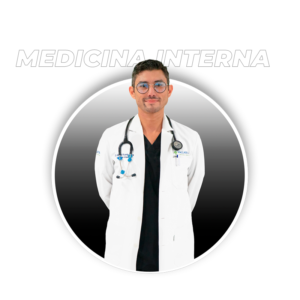
BEFORE NOTHING...
What does an internist treat?
We focus primarily on the prevention, diagnosis, treatment and monitoring of diseases for adults. It is considered an ideal family doctor for adults, since we can carry out an outpatient control of diseases and also attend to various ailments of those patients who are hospitalized.
One of our main objectives is to evaluate symptoms and reach a diagnosis in order to subsequently provide adequate treatment.
We carry out an interrogation in consultation to prevent or diagnose chronic diseases (hypertension, diabetes, heart disease, etc.). It is recommended to visit the internist at least once a year to review your health status.
We are also trained to carry out preoperative evaluations, in which it is determined if patients are in optimal conditions to undergo surgery, perioperative risks are estimated, and recommendations are issued to the patient and the surgical team to reduce these risks.
SPECIALIZED CARE
IN ADULTS

DR. ALBINO HUERTA LARA
I always look for the best alternatives for my patients, constant updating and training are a fundamental part of my philosophy. My main objective is to give correct diagnoses, the best treatment and give effective treatments so that the patient feels calm about their health.
-Medical Surgeon from the University Center of Los Altos 10-15, University of Guadalajara.
-Medical Specialist Internal Medicine by the Medical Center of Bajio, High Specialty Medical Unit No. 1 IMSS, Leon Guanajuato.

UNIVERSIDAD DE GUADALAJARA

CERTIFIED BY THE MEXICAN COUNCIL OF INTERNAL MEDICINE
24-HOUR MEDICAL EMERGENCIES
Invasive procedures such as advanced airway management, central vascular access through the subclavian and jugular routes, placement of Mahurkar catheterization, and initial management of invasive mechanical ventilation.
Years of experience
diseases and illnesses

Diabetes is a disease in which glucose (sugar) levels in the blood are too high. Insulin is a hormone produced in the pancreas that helps glucose enter the body’s cells to supply them with energy. Broadly speaking, in type 1 diabetes the pancreas does not produce insulin; In type 2 diabetes, which is more common, the pancreas does not produce enough insulin, or it is unable to transport glucose into cells. Without enough insulin, glucose stays in the blood.
Some of the risk factors for having diabetes are the following:
- Family history of diabetes
- Overweight or obesity
- Sedentary lifestyle
- Arterial hypertension
- Abnormal levels of cholesterol and/or triglycerides

Arterial hypertension is a disease in which there is a chronic elevation of pressure in the arteries, with figures equal to or greater than 140/90 mmHg. Hypertension is the leading preventable cause of cardiovascular disease in the world. Without treatment, this disease can lead to myocardial infarction, heart enlargement, and heart failure. In addition to heart damage, high blood pressure causes kidney failure, strokes, and eye damage.
Most people with high blood pressure have no symptoms, so it is known as a silent disease. Some of the symptoms that may occur are the following:
- Headache
- Palpitations
- Chest pain
- Nasal bleeding
- Dizziness
- Ear ringing

Cancer is a group of diseases characterized by the development of abnormal cells that divide, grow and spread without control in any part of the body. Cancer is the second cause of death in the world, and the third in Mexico. About a third of cancer deaths are due to tobacco use, high body mass index, alcohol consumption, low fruit and vegetable intake, and lack of physical activity.
The goal of early detection is to find the cancer when it is localized to the organ of origin, before it invades other distant tissues and organs (metastasis). Early detection is important because when abnormal tissue or cancer is found early, it may be easier to treat. By the time symptoms appear, the cancer may have begun to spread and be more difficult to treat.
It is important to go to evaluations with the internist to analyze the family history of cancer and personal risk factors, with which the best strategy for early cancer detection can be individually determined.
The timely detection of cancer is carried out through laboratory and imaging tests, mainly. Some examples of these studies are as follows:
- Mammography (breast cancer)
- Cervicovaginal cytology (cervical cancer)
- Prostate Specific Antigen (prostate cancer)
- Colonoscopy or fecal occult blood (colorectal cancer)

The Thyroid is a small gland in the front of the neck that produces hormones that control body temperature, modulate energy consumption, and regulate reproductive and digestive functions, among other things. Hypothyroidism occurs when fewer thyroid hormones are produced than your body needs. If hypothyroidism is ignored it can have serious consequences, but once diagnosed it is treatable and most patients respond well to treatment.
Some of the symptoms of hypothyroidism are:
- Fatigue
- Muscular weakness
- Dry Skin
- Swelling of the face and neck
- Cold intolerance
- Constipation
- Difficulty losing weight or unexplained weight gain
- irregular menstrual periods

Dyslipidemias are a group of diseases characterized by abnormal concentrations of cholesterol and/or triglycerides in the blood. Dyslipidemias can be caused by several conditions, such as genetic disorders, overweight, obesity, liver and thyroid gland diseases, among others.
Dyslipidemias can be a health hazard if not treated properly. Excess lipids stick to the walls of the arteries and, over time, can block blood flow. When this happens in the arteries of the heart (coronary arteries), the supply of oxygen necessary to maintain its function is reduced. Blockage of the coronary arteries results in a heart attack.
Coronary arteries are not the only ones affected by dyslipidemia, brain arteries or those of the arms and legs, among others, can also be affected. Blockage of these arteries is known as cerebral vascular disease and peripheral arterial disease.
The dangers of dyslipidemias do not disappear on their own and should be evaluated by a professional internal medicine doctor, who will give you an accurate diagnosis and treatment for the condition. Within the treatment are lifestyle changes (diet and exercise) and the use of medications that help control cholesterol and/or triglyceride levels. The goal of treatment is reduction of cardiovascular risk.
Like other joints and bones in the body, over time the spine tends to present different degenerative injuries, which vary according to sex, age, professional and recreational activity and patient comorbidities.

Asthma and COPD (chronic obstructive pulmonary disease) are diseases in which the airways swell, reducing the space through which air enters and leaves the lungs, causing air trapping and shortness of breath.
Some of the symptoms of both diseases are as follows:
- Chronic cough
- Difficulty breathing
- Hest wheeze
- Frequent respiratory infections
- Bluish lip color
Fatigue
To confirm the diagnosis of asthma and COPD, it is necessary to perform spirometry.
Asthma symptoms can be triggered by breathing in substances called allergens, which inflame the airways. Some of the most frequent allergens are: animal hair, mites, dust, pollen, changes in the weather, certain medications, tobacco smoke, etc.
COPD is mainly caused by chronic inhalation of irritating gases such as cigarette smoke. People with this disease are more likely to have heart complications, respiratory infections and lung cancer.
COPD is a progressive disease, but it is treatable. Good control of symptoms can be achieved in most people, improving their quality of life and reducing the occurrence of complications.

Fatty liver disease, or better known as fatty liver, is a disorder characterized by excess fat storage in liver cells. There are two varieties of this disease: alcoholic fatty liver and nonalcoholic fatty liver.
Non-alcoholic fatty liver disease (NAFLD) is a very common disease that affects up to 20% of adults. The most important risk factors are: overweight, obesity, insulin resistance, prediabetes, diabetes and high levels of cholesterol and triglycerides in the blood.
In most cases, fatty liver causes no signs or symptoms. When symptoms occur, the most frequent are the following:
- Chronic fatigue
- Pain or discomfort in the upper right part of the abdomen
Some people with fatty liver may develop steatohepatitis, which is an aggressive form of the disease characterized by inflammation of the liver and can progress to fibrosis (advanced scarring), cirrhosis, and liver failure.
When the disease is in an advanced stage, the following complaints may occur:
- Yellowing of the skin and eyes (jaundice)
- Bloating and abdominal pain
- Swelling in the legs and ankles
- Skin itch
- Dark colored urine
- Pale stool color
- Nausea or vomiting
loss of appetite - Tendency to bruise easily

The preoperative evaluation is a special consultation in which the internist determines if a patient is a candidate for surgery. In the preoperative evaluation consultation, the internist makes an evaluation of the characteristics of the patient and the type of procedure to be performed.
On many occasions, the preoperative assessment is the first comprehensive medical check-up that patients have in a long time, and it can include:
Detection of unknown diseases
Control of already known uncontrolled diseases
Review of laboratory studies and X-rays (CBC, blood chemistry, electrocardiogram, X-rays, etc.)
An important part of the internist’s work in preoperative evaluations is the determination of perioperative risks, which estimate the probability that the patient will present some complication during or after the procedure. Some of the risks that are evaluated are the following:
- Cardiovascular risk
- Respiratory risk
- Risk of thrombosis
- Risk of bleeding
- Risk of infections
At the end of the preoperative assessment, the internist issues a series of recommendations to the patient, the surgeon and the anesthesiologist, to reduce perioperative risks and optimize the patient’s condition before performing surgery.
GP
Responsible for preparing and monitoring your clinical history, useful in the prevention, diagnosis and treatment of systemic, chronic-degenerative diseases, as well as the correct control if there are complications.
REQUEST A CONSULTATION
CONTACT
TELEPHONE
-322 395 8911
LOCATION
- Av, Los Tules 136, Col. Díaz Ordaz, Torre Médica VMC. Consultorio 101, 48210
Puerto Vallarta, Jal.
-contacto@dralbinomedicinainterna.com